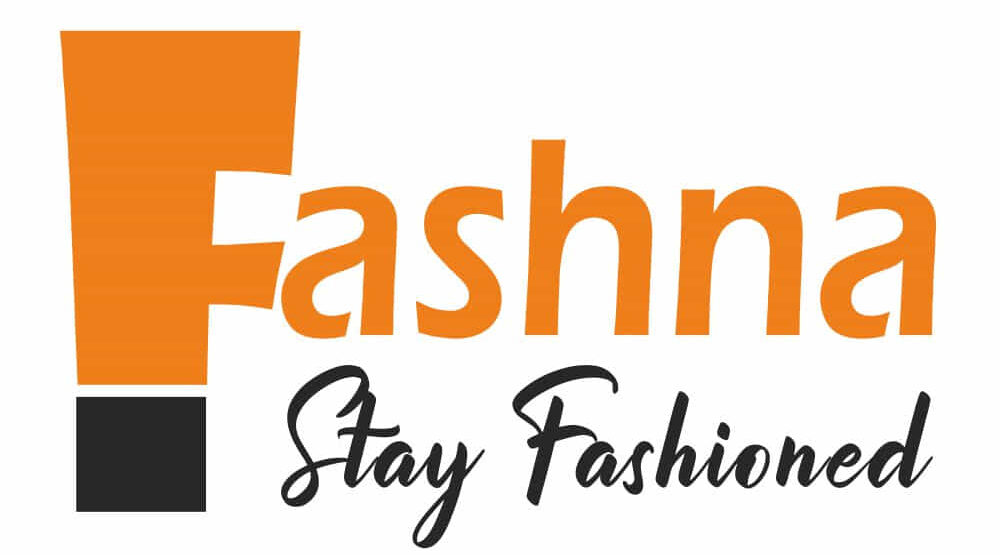
Immerse yourself in the colourful tapestry of Polish folk costumes, each intricately woven with tradition and heritage. From the vibrant Krakowiak to the bold Lubelski, these ensembles embody the essence of Poland’s cultural richness.
With each costume, we embark on a journey through the diverse regions of Poland, exploring the unique craftsmanship and symbolism that define its folk traditions. Join us as we delve into the captivating world of Polish folk costumes, celebrating the artistry and legacy passed down through generations. Experience the beauty and pride of Poland’s cultural heritage through these exquisite garments.
1. Krakowiak:
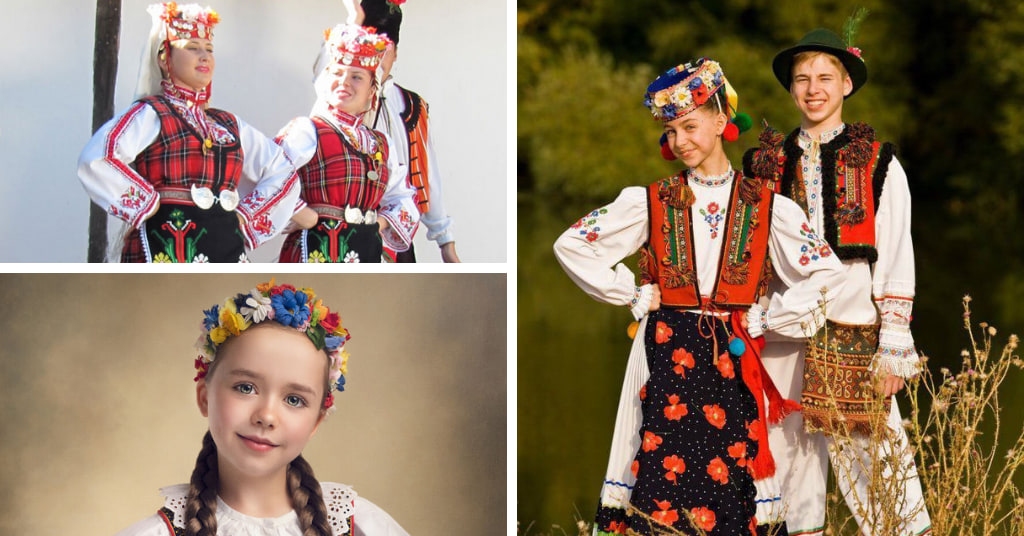
The Krakowiak costume originates from Krakow, one of Poland’s oldest and most culturally rich cities. It is characterized by its vibrant colors, intricate embroidery, and ornate detailing, typical of Polish folk costumes. Women typically wear a beautifully embellished vest, often adorned with beads or sequins, over a full skirt, showcasing the traditional elements of Polish folk costumes. The skirts are usually made of richly coloured fabrics and feature floral motifs or geometric patterns, reflecting the essence of Polish folk costumes.
Completing the ensemble is a floral headpiece, typically worn over a braided hairstyle, adding a touch of authenticity to the Polish folk costume. The Krakowiak costume is often seen during festive occasions such as weddings, folk festivals, and cultural celebrations, highlighting its significance in Polish folk culture.
2. Łowicz:
The Łowicz costume hails from the Łowicz region of Poland and is renowned for its bold red and green colors, geometric patterns, and intricate beadwork, reminiscent of traditional Polish folk costumes. Women wear elaborately embroidered blouses, often adorned with colorful ribbons and lace, paired with full, pleated skirts, echoing the classic silhouette of Polish folk costumes.
The skirts are typically striped or adorned with geometric motifs, reflecting the region’s rich textile traditions, inherent in Polish folk costumes. To complete the look, women often wear floral wreaths or headscarves decorated with ribbons and beads, adding a festive flair to the Polish folk costume. The Łowicz costume is a symbol of pride and tradition, often worn during festive occasions and cultural events, preserving the heritage of Polish folk costumes.
3. Kurpie:
The Kurpie costume originates from the Kurpie region of Poland and is characterized by its richly embroidered blouses, colorful aprons, and floral headpieces, embodying the essence of Polish folk costumes. Women wear intricately crafted blouses adorned with floral motifs and geometric patterns, reminiscent of traditional Polish folk costumes. Paired with full skirts featuring delicate pleats or gathers, the ensemble exudes the timeless charm of Polish folk costumes.
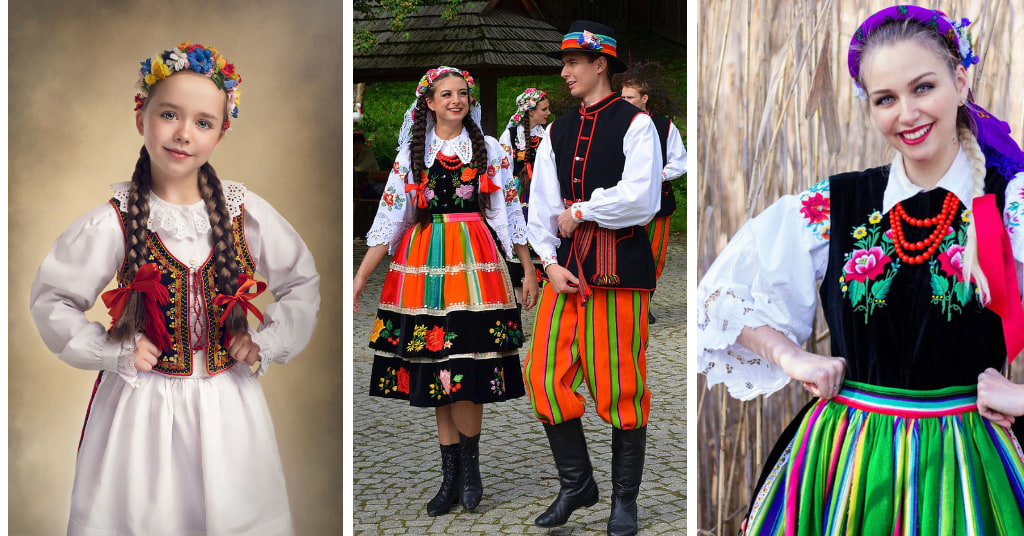
The aprons are often brightly colored and intricately embroidered, adding a pop of color and texture to the Polish folk costume. To complete the look, women wear floral headpieces adorned with ribbons, flowers, and feathers, enhancing the allure of the Polish folk costume. The Kurpie costume is a testament to the region’s rich folk traditions and is often worn during weddings, festivals, and other cultural events.
4. Kujawy:
The Kujawy costume originates from the Kujawy region of Poland and is known for its vibrant colors, floral motifs, and intricate lacework, reflecting the beauty of traditional Polish folk costumes. Women wear elaborately embroidered blouses, often featuring delicate lace inserts and floral patterns, reminiscent of classic Polish folk costumes. Paired with full skirts adorned with pleats or gathers, the ensemble captures the elegance of Polish folk costumes.
The skirts are typically made of richly colored fabrics and feature intricate embroidery or appliqué work, adding depth to the Polish folk costume. To complete the ensemble, women often wear floral headpieces and accessorize with beaded necklaces and earrings, enhancing the allure of the Polish folk costume. The Kujawy costume is a symbol of tradition and heritage, often worn during special occasions such as weddings, harvest festivals, and religious ceremonies, showcasing the timeless appeal of Polish folk costumes.
5. Kashubian:
The Kashubian costume originates from the Kashubia region of Poland and is characterized by its richly embroidered blouses, striped skirts, and intricately woven sashes, embodying the spirit of traditional Polish folk costumes. Women wear elaborately crafted blouses adorned with floral motifs, geometric patterns, and intricate lacework, typical of Polish folk costumes. Paired with skirts featuring bold stripes or colorful embroidery, the ensemble exudes the charm of Polish folk costumes.
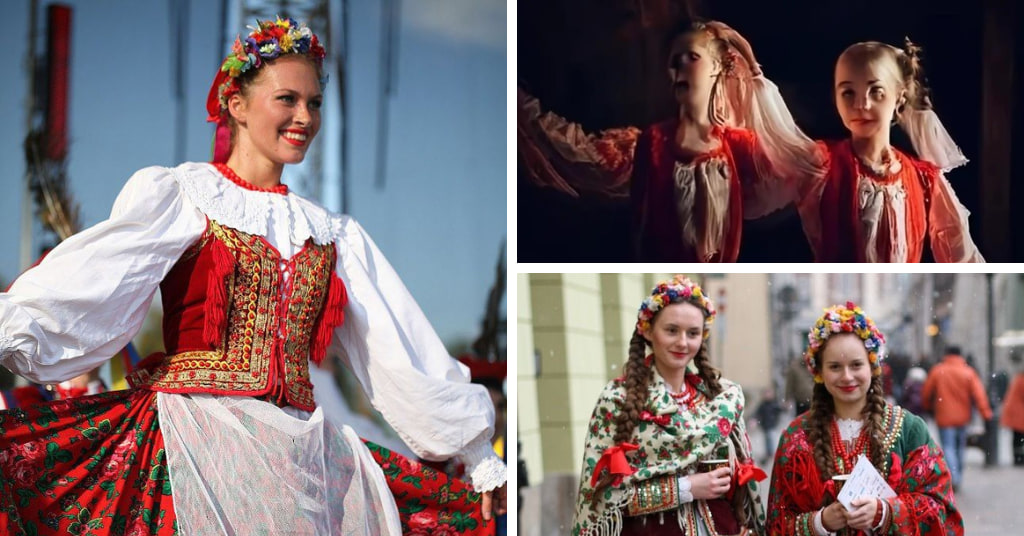
Read this also:- Best 18 hairstyles At Work You Can Try On Next Office Visit
The sashes, often woven from brightly colored yarns, are worn around the waist and tied in elaborate knots or bows, adding a touch of elegance to the Polish folk costume. To complete the look, women often wear floral headpieces adorned with ribbons, feathers, and beads, elevating the beauty of the Polish folk costume. The Kashubian costume is a symbol of pride and identity, often worn during cultural festivals, weddings, and other special occasions, celebrating the rich heritage of Polish folk costumes.
6. Góralski:
The Góralski costume hails from the Tatra Mountains region of Poland and is characterized by its heavy wool skirts, embroidered vests, and intricate lacework, reminiscent of traditional Polish folk costumes. Women wear full skirts made of thick wool or felted fabric, often adorned with floral embroidery or geometric patterns, showcasing the craftsmanship of Polish folk costumes. The vests are typically embellished with intricate beadwork, sequins, and metallic threads, adding a touch of glamour to the Polish folk costume.
To keep warm in the chilly mountain climate, women often wear brightly colored shawls or scarves draped over their shoulders, complementing the Polish folk costume. The Góralski costume is a symbol of mountain life and tradition, often worn during festive occasions, weddings, and cultural events, preserving the legacy of Polish folk costumes.
7. Opoczno:
The Opoczno costume originates from the Opoczno region of Poland and is known for its vibrant colors, geometric patterns, and elaborate beadwork, reminiscent of traditional Polish folk costumes. Women wear elaborately embroidered blouses, often featuring intricate lace inserts and colorful beadwork, typical of Polish folk costumes. Paired with full skirts adorned with bold stripes or geometric motifs, the ensemble captures the essence of Polish folk costumes.
Read this also:- Fashion Guide: What to Wear in Poland? 25 Stylish Poland Outfit Ideas
The skirts are typically made of richly colored fabrics and feature intricate embroidery or appliqué work, adding depth to the Polish folk costume. To complete the ensemble, women often wear floral headpieces and accessorize with beaded necklaces and earrings, enhancing the allure of the Polish folk costume. The Opoczno costume is a symbol of tradition and craftsmanship, often worn during weddings, festivals, and other cultural celebrations, showcasing the timeless beauty of Polish folk costumes & polish folk dances.
8. Rzeszowski:
The Rzeszowski costume hails from the Rzeszow region of Poland and is characterized by its richly embroidered blouses, colorful aprons, and intricately woven sashes, embodying the essence of Polish folk costumes. Women wear elaborately crafted blouses adorned with floral motifs, geometric patterns, and intricate lacework, typical of Polish folk costumes. Paired with skirts featuring bold stripes or colorful embroidery, the ensemble exudes the charm of Polish folk costumes.
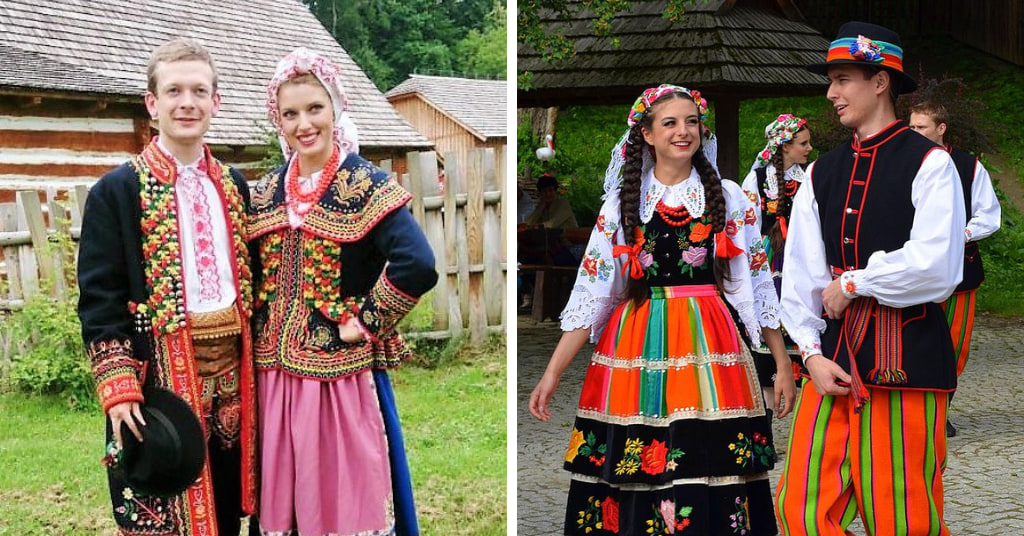
The aprons are often brightly colored and intricately embroidered, adding a pop of color and texture to the Polish folk costume. To complete the look, women often wear floral headpieces and accessorize with beaded necklaces and earrings, enhancing the allure of the Polish folk costume. The Rzeszowski costume is a symbol of tradition and pride, often worn during special occasions such as weddings, festivals, and religious ceremonies, preserving the heritage of Polish folk costumes.
9. Płocki:
The Płocki costume originates from the Płock region of Poland and is known for its bold colors, geometric patterns, and elaborate beadwork, typical of Polish folk costumes. Women wear elaborately embroidered blouses, often featuring intricate lace inserts and colorful beadwork, reminiscent of classic Polish folk costumes. Paired with full skirts adorned with bold stripes or geometric motifs, the ensemble captures the vibrancy of Polish folk costumes.
The skirts are typically made of richly colored fabrics and feature intricate embroidery or appliqué work, adding depth to the Polish folk costume. To complete the ensemble, women often wear floral headpieces and accessorize with beaded necklaces and earrings, enhancing the allure of the Polish folk costume. The Płocki costume is a symbol of tradition and craftsmanship, often worn during weddings, festivals, and other cultural celebrations, celebrating the rich heritage of Polish folk costumes.
10. Lachy Sądeckie:
Lachy Sądeckie costumes originate from the Sądeckie region of Poland and are characterized by their richly embroidered blouses, colorful aprons, and intricately woven sashes, embodying the spirit of traditional Polish folk costumes. Women wear elaborately crafted blouses adorned with floral motifs, geometric patterns, and intricate lacework, typical of Polish folk costumes. Paired with skirts featuring bold stripes or colourful embroidery, the ensemble exudes the charm of Polish folk costumes & Walking Shoes for Plantar Fasciitis.
Read this also:- Best 6 Pheromone perfume for women to buy today
The aprons are often brightly colored and intricately embroidered, adding a pop of color and texture to the Polish folk costume. To complete the look, women often wear floral headpieces and accessorize with beaded necklaces and earrings, enhancing the allure of the Polish folk costume. The Lachy Sądeckie costume is a symbol of tradition and heritage, often worn during special occasions such as weddings, festivals, and religious ceremonies, celebrating the timeless beauty of Polish folk costumes.
11. Beskidzki:
The Beskidzki costume originates from the Beskid Mountains region of Poland and is characterized by its heavy wool skirts, embroidered vests, and intricate lacework. Women wear full skirts made of thick wool or felted fabric, often adorned with floral embroidery or geometric patterns. The vests are typically embellished with intricate beadwork, sequins, and metallic threads, creating a stunning visual effect. To keep warm in the chilly mountain climate, women often wear brightly colored shawls or scarves draped over their shoulders. The Beskidzki costume is a symbol of mountain life and tradition, often worn during festive occasions, weddings, and cultural events.
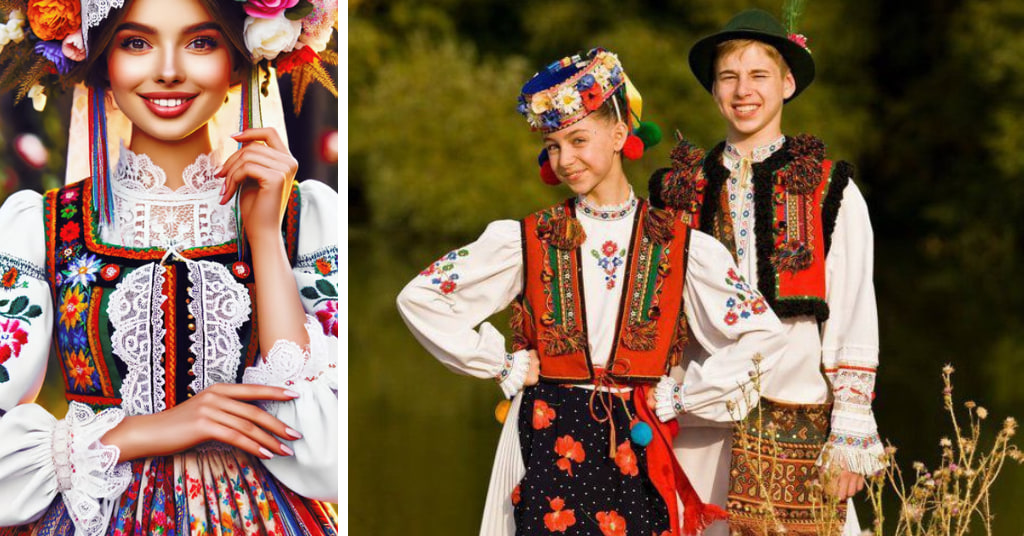
12. Lubelski:
The Lubelski costume hails from the Lublin region of Poland and features richly embroidered blouses, colorful aprons, and intricately woven sashes. Women wear elaborately crafted blouses adorned with floral motifs, geometric patterns, and intricate lacework, paired with skirts featuring bold stripes or colorful embroidery. The aprons are often brightly colored and intricately embroidered, adding a pop of color and texture to the ensemble. To complete the look, women often wear floral headpieces and accessorize with beaded necklaces and earrings. The Lubelski costume is a symbol of tradition and pride, often worn during special occasions such as weddings, festivals, and religious ceremonies.
13. Bocheński:
Bocheński costumes are known for their vibrant colors, geometric patterns, and elaborate beadwork. Women wear elaborately embroidered blouses, often featuring intricate lace inserts and colorful beadwork, paired with full skirts adorned with bold stripes or geometric motifs.
The skirts are typically made of richly colored fabrics and feature intricate embroidery or appliqué work. To complete the ensemble, women often wear floral headpieces and accessorize with beaded necklaces and earrings. The Bocheński costume is a symbol of tradition and craftsmanship, often worn during weddings, festivals, and other cultural celebrations & Traditional Dress of Poland.
14. Mazowiecki:
The Mazowiecki costume originates from the Mazovia region of Poland and features richly embroidered blouses, colorful aprons, and intricately woven sashes. Women wear elaborately crafted blouses adorned with floral motifs, geometric patterns, and intricate lacework, paired with skirts featuring bold stripes or colorful embroidery.
The aprons are often brightly colored and intricately embroidered, adding a pop of color and texture to the ensemble. To complete the look, women often wear floral headpieces and accessorize with beaded necklaces and earrings. The Mazowiecki costume is a symbol of tradition and pride, often worn during special occasions such as weddings, festivals, and religious ceremonies.
15. Sieradzki:
Sieradzki costumes are characterized by their bold colors, geometric patterns, and intricate lacework. Women wear elaborately embroidered blouses, often featuring intricate lace inserts and colorful beadwork, paired with full skirts adorned with bold stripes or geometric motifs. The skirts are typically made of richly colored fabrics and feature intricate embroidery or appliqué work. To complete the ensemble, women often wear floral headpieces and accessorize with beaded necklaces and earrings. The Sieradzki costume is a symbol of tradition and craftsmanship, often worn during weddings, festivals, and other cultural celebrations.
Conclusion:-
In conclusion, Polish folk costumes, spanning from Krakowiak to Lachy Sądeckie, encapsulate the rich cultural heritage and traditions of Poland. Each costume reflects unique regional influences, intricate embroidery, vibrant colors, and ornate detailing.
Whether it’s the bold reds and greens of Łowicz or the heavy wool skirts of Góralski, these costumes serve as a testament to Poland’s diverse folklore and craftsmanship. Worn during festive occasions, weddings, and cultural events, Polish folk costumes not only preserve the legacy of the past but also continue to inspire pride and admiration today. They are a cherished symbol of tradition, identity, and the enduring spirit of the Polish people.
Recommended Readings:-
What's Your Reaction?
Barkha Sachdeva is a B.Com (Hons) graduate from Delhi University. Passionate about crafting content, she enjoys writing about fashion, beauty, technology, and travel. With three years of content writing experience, she possesses valuable insights and ideas in these domains.
